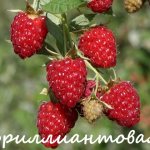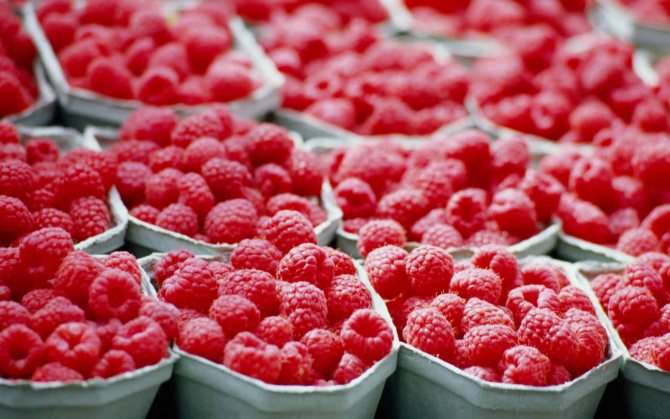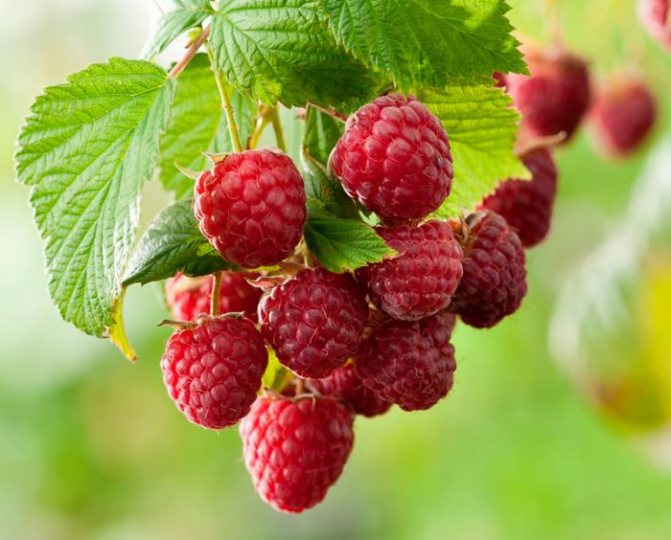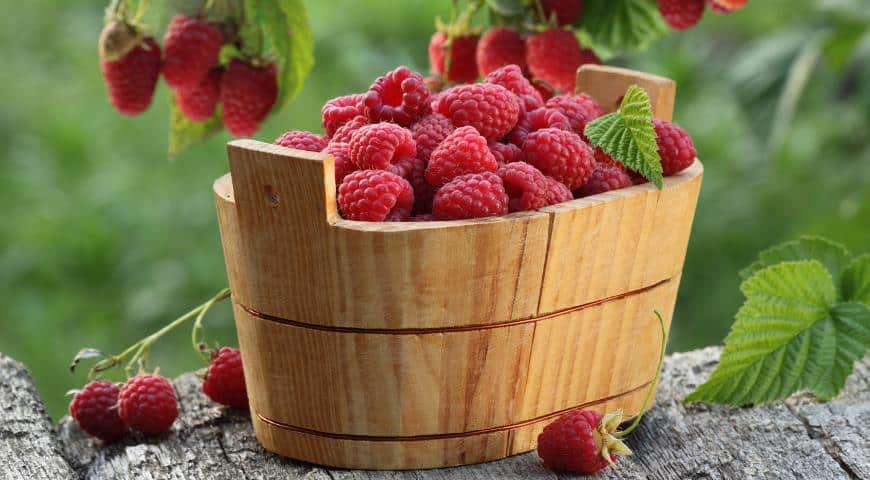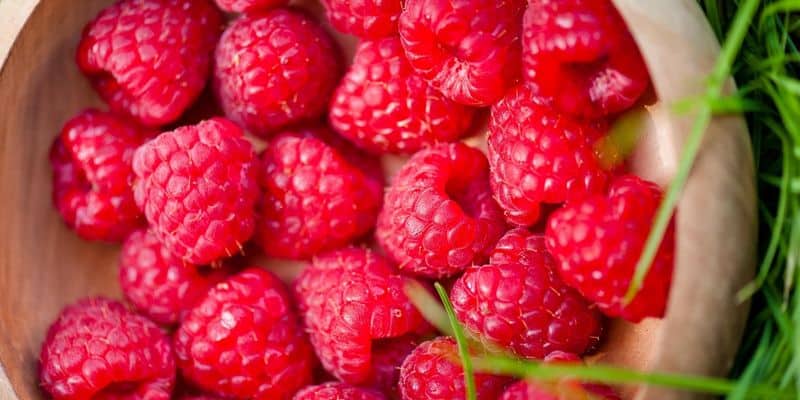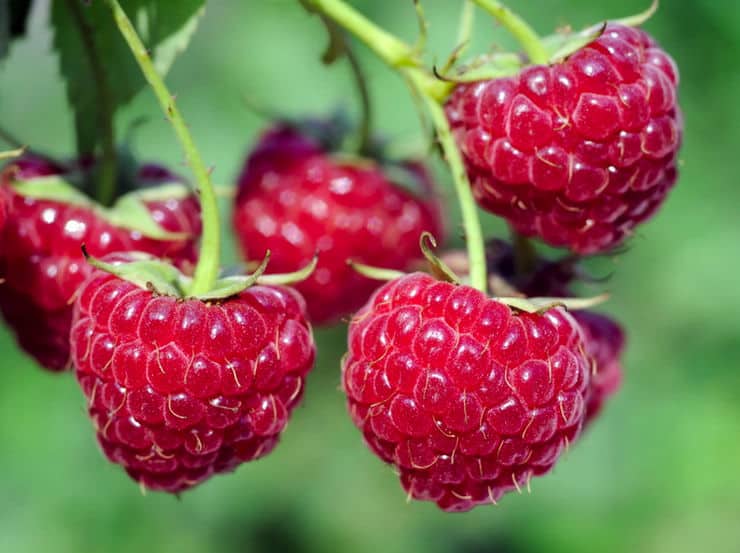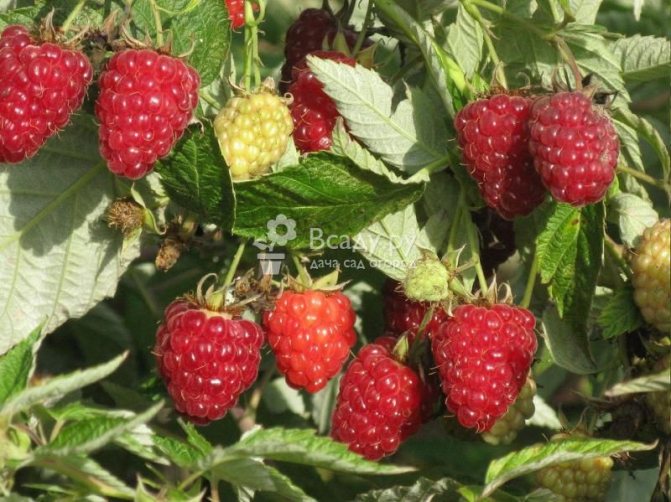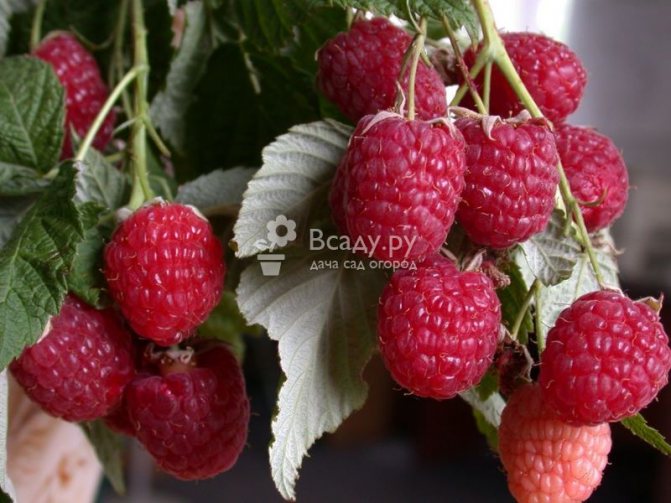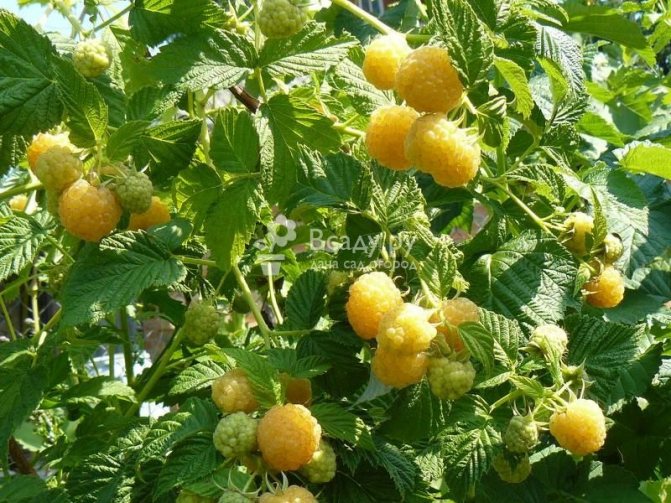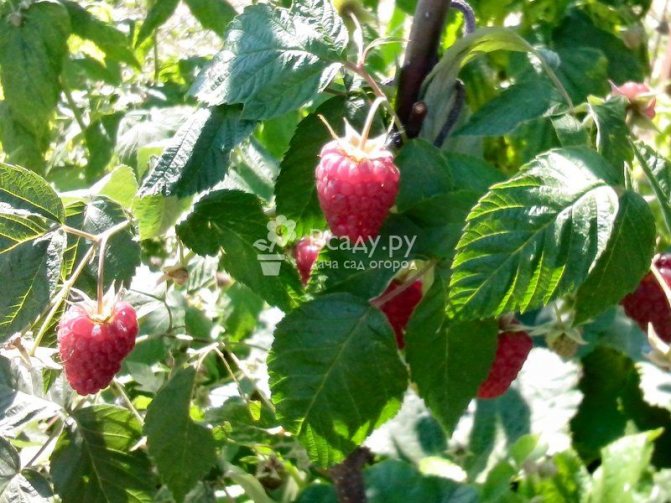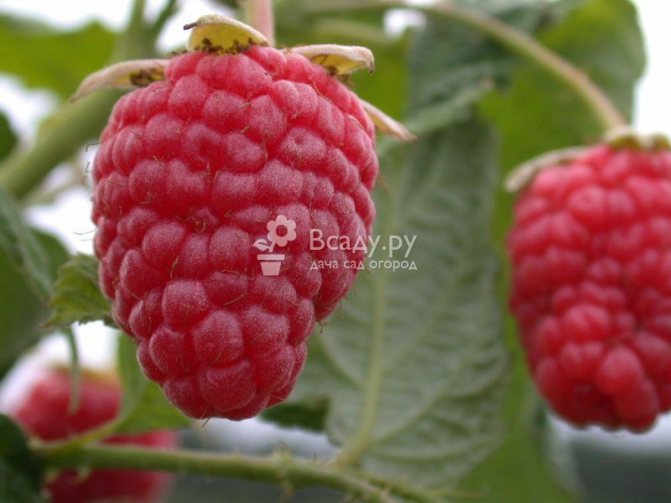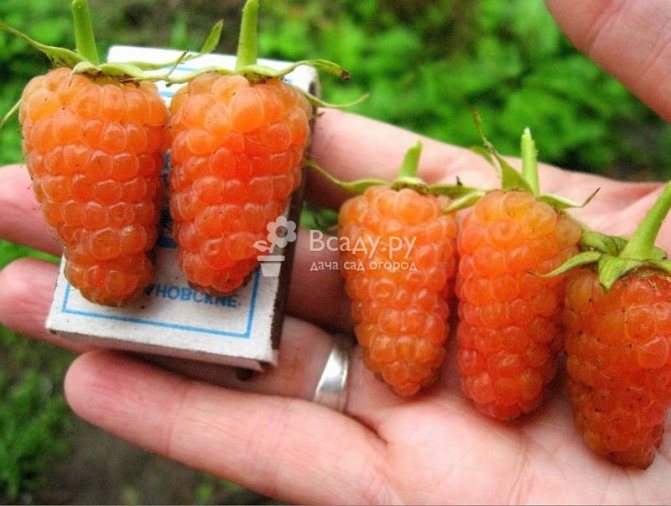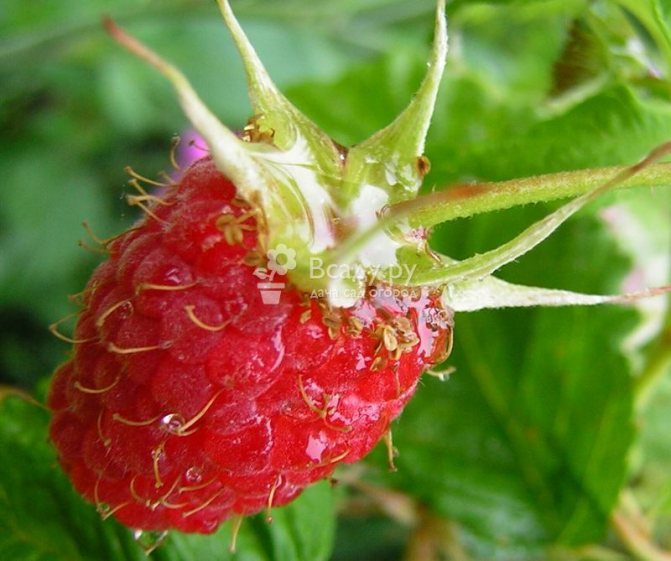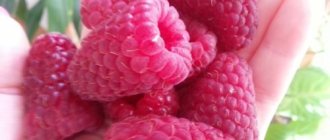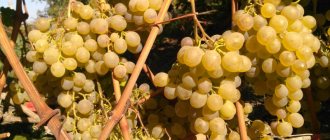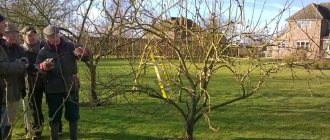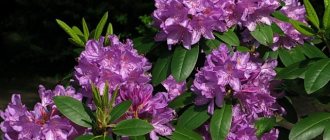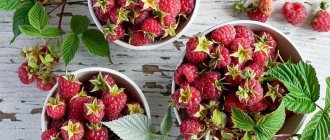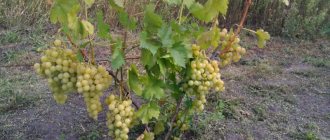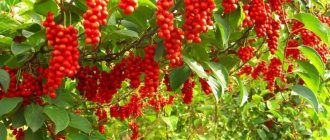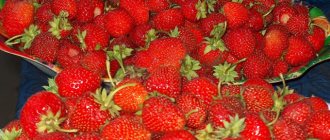Apricot
This is one of the most exotic varieties of raspberries. Although the bushes grow small, they nevertheless need a garter. The berries ripen on them are medium-sized and neat, yellow in color with a pinkish tinge, they are easily separated from the fruit. The shape of the raspberry is blunt-conical, the taste of the berries is reminiscent of apricot.
| Appointment | Productivity (kg per bush) | Berry weight (g) | Bush height (m) | Maturation (period) | |
| 2,5-3,5 | 3-4 | 1,3-1,5 | Early August - late October | ||
Brilliant
Brilliant is a thornless, strongly branching variety of raspberries with low stems (up to 1.5 m), outwardly similar to currants. The berries have an excellent presentation, but have a mediocre taste and are practically devoid of aroma. Forms little root cuttings, does not "creep" over the site, but reproduces poorly. It bakes heavily in hot sunny weather, the drupes are poorly adhered and fall apart during collection, with timely watering this deficiency is leveled.
Detailed description of the variety Brilliant

The best varieties of large-fruited raspberries for the middle lane
Any variety of large-fruited raspberries will give really large fruits only with strict adherence to the rules of agricultural technology. This is because these varieties come from English forms of culture that were formed in milder climates. Therefore, in the middle lane, they have limited winter hardiness: the shoots will have to be bent and covered.
These varieties are also characterized by the genetic instability of the large-fruited trait and the possibility of the appearance of plants with small fruits in the offspring. In order to still get a high yield of large fruits, you will have to make enhanced fertilizing, organize abundant watering, and sufficient lighting.
The palatability of raspberries is influenced not only by the size of the fruit, but also by the shape and color.
- Cumberland. This black raspberry variety is resistant to diseases and pests. Winter hardy. Dark shiny berries with a white bloom between the drupes, with the aroma and taste of blackberries, sweet and sour. Well transported. In the middle lane, the yield per bush is 3.5-6 kilograms. Black raspberries do not give root shoots. But throughout the year it is decorative and serves as an adornment of the site - its arched long shoots with a bluish bloom grow from the base of the bush and look very impressive.
- Arbat. The variety was bred by Moscow breeders by crossing two Scottish hybrids. It is considered one of the best medium-early large-fruited high-yielding varieties. From a bush, you can get up to 5 kilograms of fruit. The bright red berries are cone-shaped, sweet and aromatic. Their weight is as much as 15-18 grams. On each of the large spreading bushes, up to 12 shoots without thorns are formed. The variety is frost-resistant - tolerates temperatures up to -30 ° C. If the frosts are even stronger, raspberry bushes bend to the ground, hiding under a snow cover. Resistant to diseases and pests.
- The golden giant. A large-fruited variety with a high yield - up to 8 kilograms per bush. Large dark golden berries weigh 8-14 grams. They just melt in your mouth. The variety is very winter-hardy. But it is better not to transport it.
- Terenty. It is considered one of the best large-fruited varieties. Developed by domestic breeders. The purple-red, conical-shaped berries weigh up to 15 grams. Nice to taste. Productivity 6-10 kilograms per bush.The variety is transportable, resistant to diseases and pests.
Malina Arbat is one of the most productive varieties of the Moscow region. Differs in large elongated berries (15-18 g) of deep red color and high resistance to diseases. Up to 9 kg of sweet raspberries can be removed from one bush per season. The berries are dense, store well and retain their shape during transportation. An adult bush is quite sprawling - up to 2 m in height.
A variety of an unusual shade, the berries of which have a light honey taste. It is easy to collect 10 kg of raspberries from one bush - and this is not the limit! The berries do not crumble for a long time, but they are not very suitable for processing, because poorly keep their shape after removing from the bush. Better to eat them fresh. Fruiting period lasts from early July to early or mid-August.
Patricia
Raspberry Patricia is the leader among large-fruited varieties. It is so fruitful that it is sometimes confused with remontant. The fruits of the variety are sweet, conical in shape. The weight of one berry is 6-10 g. It is easy to collect 4 kg of raspberries from one bush, in especially fruitful years - up to 8 kg. Fruiting lasts from June to September. The berries do not break when removed from the stalk, and are great for processing, but they are less transported.
Today, varieties of large-fruited raspberries are the most common and famous. Representatives of this species bring a rich harvest and are grown both on private plots and on an industrial scale.
"Patricia"
The most fertile variety. From one bush, you can collect from 4.5 to 5 kg. The yield can be doubled by constantly caring for the plant, feeding it and fertilizing the soil.
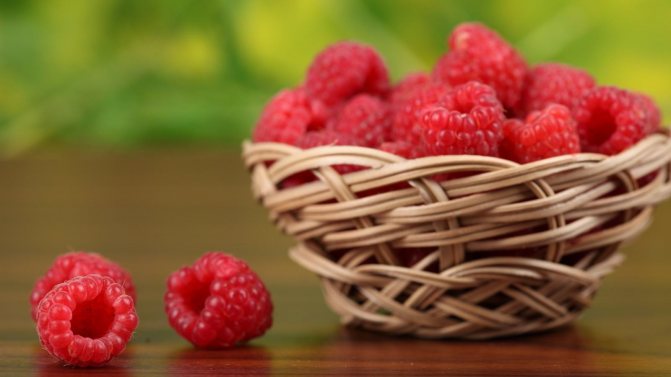

Fruits are large in size, conical in shape, deep red in color, the weight of 1 piece varies from 4.1 to 5.9 grams. The berries do not crumble from the bush, when harvesting, they are well removed from the stalk, do not crumple. The taste of the fruits is pleasant and delicate, juicy, they contain a small amount of seeds. "Patricia" is used for cooking, fresh and canning.
Raspberry bushes are of medium size, about 1.8 m. Fruits appear in the first half of July, and the fruiting period ends at the end of summer. Representatives of this species tolerate frosts well down to -29 degrees. And also they are not susceptible to diseases such as anthracnose and didemella. Late blight may be dangerous for this variety.
"Eurasia"
Representative of the standard type. The variety is unpretentious to soil quality and weather conditions. Plant height up to 1.6 m, so harvesting is very convenient. Berries are dark red, conical in shape. They are perfectly stored, retain their presentation, and also do not lose their useful and taste properties. Raspberries taste sweet, with a slight sourness. The plant tolerates climatic changes well and is suitable for Siberia and the Urals. The variety is resistant to harmful insects.
"Abundant"
A variety of large-fruited raspberries. The plant is of medium size, it has no thorns.
- The total mass of fruits harvested from one bush is about 5.2 kg.
- The weight of one berry is 9.9 grams.
- Raspberry color is deep red.
Fruits are oblong in shape, easily removed from the branch. The variety easily tolerates transportation and transportation, and is also resistant to diseases and low temperatures. "Abundant" refers to dessert types. The variety can be grown for the purpose of selling.
"Maroseyka"
The bushes of the plant do not have thorns. "Maroseyka" is a large-fruited variety that produces large berries weighing up to 11.9 grams.
Fruits are red, covered with a slight bloom. They taste tender and aromatic.
Plant height can reach 1.6 m. "Maroseyka" is moderately winter-hardy and is suitable for growing in the south of Russia and in the Moscow region.
"Yellow giant"
Large-fruited variety. The weight of one fruit is from 10.1 to 12.1 grams. Berries are light yellow in color with a rich honey aroma. The pulp resembles the taste of forest raspberries.Can be used both fresh and for preparations for the winter.
From one shoot, you can collect from 10.1 to 12.6 kg of raspberries. The trunk of the plant is strong and powerful, the shoots are thick. Suitable for growing in the Moscow region, since it is not susceptible to the appearance of diseases and the spread of viruses.
We offer you to familiarize yourself with: Carrot juice useful properties and contraindications
"Apricot"
The plant is small in size, needs a garter of shoots. The variety is exotic and has positive reviews from experienced gardeners. "Apricot" bears many yellowish-pink fruits. The berries are easily removed from the bush and have a blunt-conical shape. The fruit pulp tastes like an apricot. "Apricot" is not susceptible to the appearance of diseases and the spread of pests. Suitable for preserving and making delicious amber-colored jam.
"Orange miracle"
Berries "Orange Miracle" differ in their size, the weight of one unit - from 8.1 to 10.1 grams, rich yellow color, as well as delicate taste. The fruits are firm and can be transported well. The crop can be harvested all summer long.


Bushes of medium size, do not require additional supports. Plant height 1.75 m. "Orange miracle" tolerates frost well and is not prone to the occurrence of various diseases.
This type of raspberry is sometimes called the best variety for the middle lane. The bush has decorative properties, blooms very beautifully and bears fruit, so this raspberry in itself is a decoration of the garden. Neat yellow berries are useful for people with weakened immunity, allergy sufferers and pregnant women. They do not crumble from the bush for a long time and are perfectly stored. The plant has high frost resistance and is practically not afraid of various diseases.
| Appointment | Productivity (kg per bush) | Berry weight (g) | Bush height (m) | Maturation (period) | |
| 4-6 | 5-8 | 1,7-2 | Mid July - mid October | ||
Anna
Anna is a remontant yellow raspberry variety of the USA selection. Bushes of medium height (1.2-1.8 m.), Erect, compact, leaning under the weight of the crop, require the obligatory arrangement of trellises. The berries are large (5-7 g), light yellow, blunt-conical in shape. The drupes are tightly linked to each other, the berry can be transported over long distances, does not wrinkle, does not flow, does not deteriorate.
Taste characteristics are excellent. The berries are sweet, aromatic, with a rich dessert aftertaste. Suitable for fresh consumption, any kind of processing, freezing. Shoots are covered with thorns, but thorns are rare, small. Of the features, one can distinguish light green foliage of young shoots, fruiting only in the upper quarter of the stem, susceptibility to verticillary wilt. The variety is new, but it is already being sold in nurseries in Russia and has good reviews from gardeners, primarily for the delicious sweet fruits.
Detailed description of the variety Anna
Indian summer
This is the first remontant raspberry variety bred in Russia. Designed for cultivation in the southern and central regions. The bush is sprawling, rather tall and erect. Berries of medium size, round-conical or spherical in shape. With the onset of ripeness, they acquire a dark crimson color. The taste is sweet and sour, but without a pronounced aroma.
| Appointment | Productivity (kg per bush) | Berry weight (g) | Bush height (m) | Maturation (period) | |
| 1-2 | 3-4 | 1,8-2 | Early June - early July. Early September - mid October | ||
Glen Coe
Glen Coe is a dark purple raspberry variety that is often ranked alongside the black chokeberry varieties. The bushes are devoid of thorns, medium spreading, do not form shoots, do not "spread over the site." Berries of medium size, spherical, dark purple with a waxy bloom (inside dark ruby), devoid of the characteristic raspberry aroma, but tasty and sweet. When feeding with potassium-magnesium complexes, the taste of the berries is significantly improved, the size increases.High winter hardiness, multiplies by rooting tops. Refers to ordinary summer varieties, does not show signs of remontance. Laterals and "fruits" are long, double pruning according to Sobolev is not carried out, otherwise the bush will be unnecessarily thickened.
Detailed description of the Glen Coe variety
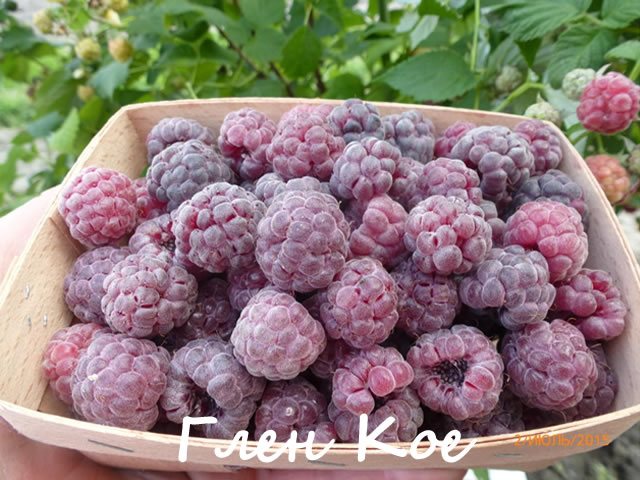

Standard raspberry varieties
"Maroseyka"
Common raspberry varieties are time-tested and are traditional varieties for growing in garden plots by amateurs and experienced summer residents. Representatives of this species are distinguished by their pleasant taste and resistance to adverse conditions. They do not require special care, but they also do not bring a large harvest. The main thing is to trim raspberries correctly and on time, this is described in a separate article. The berries are small and lightweight.
"Malakhovka"
The volume of fruit that this traditional variety bears is not very large each season. From one bush, you can collect about 2.2 kg of raspberries. The berries have a sweet taste, pleasant aroma, rich smell. The weight of one fruit is about 2.8 g, it has an elongated shape and a soft skin, under which many seeds are hidden.
Representatives of the species tolerate transportation well. The plant is afraid of gray rot, but it is resistant to the effects of spider mites.
"Meteor"
"Meteor" is a representative of the productive class. The fruits are round, small in size, the weight of one is from 2.4 to 3.1 grams. The color of the berries is intense, red. The pulp is aromatic and tasty. The first crop can be harvested in June.
Plant height up to 2 meters. The mass of berries harvested from the bush per season is 2 kg. "Meteor" tolerates low temperatures well and is not susceptible to the appearance of various types of diseases.
"Crane"
The berries of this variety are large, red in color, the mass of one is from 2, 3 to 3.5 grams. The fruits of "Crane" have a conical chopped off shape and are distinguished by their density. The pulp tastes rich and tasty. Representatives of this species tolerate transportation well.
One bush can be harvested up to 2 kg. "Zhuravlik" perfectly tolerates low temperatures and is not affected by raspberry mites and fungal diseases.
"Brigantine"
The variety is a representative of the productive class. The weight of one berry is about 3.9 grams. Round fruits have a pomegranate hue and taste great. One plant per season produces a crop weighing 2.5 kg.
The bushes are small, reaching 1.9 m in height. "Brigantine" is resistant to frost and drought. Raspberries are not susceptible to the spread of diseases such as anthracnose, spider mites.
A standard variety of raspberries, otherwise called a raspberry tree, and is a completely new species in the cultivation of raspberry bushes. This species got its name due to its powerful, tall and sturdy trunk.
"Tarusa"
The bushes of the Tarusa plant do not need support at all, since they have strong stems. The mass of one berry is from 10, 3 to 12.9 grams. The color of the pulp is intense, red with a raspberry aroma. The fruit can be easily removed from the branches and can be easily transported.
From one bush per season, you can collect from 3.1 to 4.2 kg of raspberries. The plant has an average frost resistance. It is necessary to cover if the air temperature is below -30 degrees.
"Cap of Monomakh"
Due to its oblong shape with a blunt end, the variety got its name. The color of the berries is crimson, with a dark shade. The pulp tastes sweet. "Cap of Monomakh" refers to partially remontant varieties, the first fruits appear on the bushes at the end of summer. The fruiting period ends after the onset of frost. The mass of one berry is up to 7.1 gr.
During the season, you can collect from 3.3 to 5.4 kg of raspberries from one unit. The plant is distinguished by highly branched bushes and good frost resistance.
Glen Ample
A variety from Scotland, quite famous in Europe. Fruits are round, oblong, not saturated with red hue. The mass of one berry varies from 5.1 to 6 grams, some weigh up to 10 grams.Raspberries of this type have a pleasant sweet taste, with a slight sourness, and are also well stored, easily tolerate transportation and retain their presentation for a long time.
The height of the plant is from 3.6 to 4.1 m. 1.7 kg of berries can be obtained from one bush per season. The variety easily tolerates frost and heat. Glen Ample is not susceptible to the spread of diseases and harmful insects.
Octavia
A new variety of raspberries from England. The berries are red, large in size, weighing up to 8.1 grams. The fruits adhere firmly to the bush and do not fall off even after prolonged rain. Octavia tastes great and can be transported well.
The plant is small in size, covered with berries. One bush per season can bring up to 5.3 kg of raspberries. The variety is not susceptible to diseases and tolerates low temperatures well.
This variety will delight its owners only closer to August, in the third decade of July. But during this time, large and tasty fruits will ripen on the bushes! The weight of one raspberry sometimes reaches 3.8 g, and 2.5 kg of berries can be easily collected from one bush. The brigantine grows compactly. Its shoots are erect, there are few thorns and they are rarely located.
The Scottish raspberry variety Glen Ample is also called the "raspberry tree" because the bush grows very powerful and does not have thorns. Frost and drought are not terrible for the plant, and the resistance to common diseases and pests is high. The variety is appreciated not only for these qualities. Glen Ample produces delicious berries weighing 5-10 g.
They have a slight sourness, but from one shoot you can get 1.5-2 kg of raspberries at once. The length of the shoots is 3-3.5 m. The bush bears fruit during July. If the spring was early, the first harvest can be obtained at the end of June. The variety does not require shelter for the winter if the air temperature does not drop below –30 ° C.
We suggest that you familiarize yourself with: How to store a carrot crop until spring
If you want to eat raspberries as early as possible, plant the Meteor variety. Already at the end of June, you will receive ripe berries weighing up to 3 g. And until the end of fruiting, which on average is two weeks, you can collect about 2 kg of rounded ruby fruits from the bush. The crop can be eaten fresh or frozen.
Raspberry variety Octavia originated in England. The berries of the variety are red, large - up to 8 g. They have an excellent taste, in addition, they do not fall off the bush for a long time, even in unfavorable weather. Easy to store and transport. You can collect about 5 kg of berries from one bush. The thorns are mainly found in the lower part of the bush, so there will be no problems with harvesting.
The shoots are powerful and require a garter. Octavia is hygrophilous, without sufficient watering and dressing, the crop can acidify. Fruiting occurs in late July - early August and lasts a little more than a month. Disease and pest resistance is good, but there is a risk of gray mold infestation. It is worth sheltering for the winter.
Patricia
Crane is a mid-season remontant raspberry variety
A repaired early fruiting variety. The bushes are compact, with weak branching. The berries are not very large, beautifully elongated, bright red, sweet and sour. Under suitable conditions, fruiting begins in late July and then resumes in the fall. Productivity and, importantly, crop safety are at a high level. Disease resistance is average, the plant requires regular care, timely watering and feeding.
| Appointment | Productivity (kg per bush) | Berry weight (g) | Bush height (m) | Maturation (period) | |
| 2-3 | 3-4 | 1,2-1,4 | Mid July - mid September | ||
The Bryansk miracle lives up to its name. The variety is very fruitful, bears fruit from the second half of August to autumn frosts. From one bush you can collect up to 3 kg of berries with an average weight of 9 g. But with good care, larger specimens up to 20 g will also ripen. The berries of the variety have a recognizable elongated shape.
The shoots of the bush are thorny, but there is a pleasant feature for which the Bryansk miracle is especially appreciated: two fruiting branches grow from one node of the shoot. Moreover, raspberries bear fruit almost along the length of the entire shoot, and she has about 1.5 m. But the variety cannot boast of resistance to diseases.
Raspberry Zhuravlik is a promising domestic variety that deserves the attention of berry lovers. Among its advantages: unpretentiousness, good yield and tasty fruits. The bush bears fruit from mid-July to the very frost with large conical berries (up to 3.5 g). The bush itself is compact, with powerful shoots up to 2 m in height.
The thorns are poorly developed and not very sharp. The variety is resistant to raspberry mites and rot. Winter hardiness of the Crane is above average. Despite the renovation, it is recommended to grow the bush for one harvest so that the taste of the berries does not deteriorate. Therefore, after summer fruiting in the fall, the entire aerial part must be completely cut out.
Do you want to grow unusual raspberries in the country? An excellent option is the Orange Miracle variety! The appearance of these berries is exotic, and the taste is unforgettable. Juicy and shiny fruits of a bright shade are rather large - up to 5.5 g, sometimes 10-gram specimens are also found. The raspberry bush is powerful and spreading, covered with thorns, so harvesting is not always easy.
Historical sources indicate that the cultivation of raspberries in the territory of the modern Moscow region has been carried out since the times of Ancient Rus. Prince Yuri Dolgoruky, who appreciated the useful properties of the plant, organized gardens for its cultivation, reminiscent of modern breeding bases. And it is not without reason that raspberries took root well, because the climatic conditions are completely conducive to this.
Did you know? Cultivation of raspberries is one of the longest, since it has been purposefully grown as a fruit crop for more than 2 millennia.
Today, many species have been bred, including large-fruited, common and remontant varieties. Each of them may well grow in the territories of the Moscow region and the middle zone, giving a good harvest with proper care. The varieties have their own distinctive characteristics, but they have one thing in common - the undoubted benefits for humans. Moreover, all plant fragments are used for recreational purposes.
Berries have hemostatic, antitoxic effects. The content of salicylic acid in them causes an antipyretic effect, and a large amount of copper helps to get rid of depression. Regular consumption of the product strengthens the immune system, improves complexion and the digestive system.
Raspberry leaves are used in the treatment of viral diseases. For example, tincture of the leaves can significantly alleviate the condition of herpes. Raspberry stalks cut in the fall can be dried, broken into small pieces and added to tea leaves. Taking such a drink during the winter will significantly strengthen the immune system and help with colds.
It is noteworthy that raspberries do not lose their healing properties after heat treatment, therefore, in winter, you can cope with colds with the help of raspberry jam.
This rating was compiled by amateur gardeners and members of the professional community who are involved in the zoning of raspberry varieties.
| Variety | Characteristic |
| Maroseyka | The variety is considered one of the best summer varieties. Bred 40 years ago. Yielding (up to 5 kg per bush), unpretentious. The berries are large, with a pronounced raspberry flavor, light red in color. Conical shape. Weight 4-10 g. The variety is not standard, but has thick, erect, branched stems. There are no thorns. |
| Lashka (Lyashka) | An early ripe summer fruitful variety. Bred in Poland. The berries are sweet, oblong, large - weight 6 g. The height of the shoots is more than 2 m. Fruiting from mid-June. Winter hardy, picky about the soil. |
| Sun | An early summer variety. Resistant to freezing, disease.The height of a powerful bush with small thorns is 2 m. The mass of rounded large berries is up to 5 g. The color is purple, the taste is pleasant, dessert. Fragrant. |
| Pride of Russia | Medium early variety. The bushes are medium-sized, compact with many lateral shoots. Each branch has bunches of 25-30 berries. They are red, velvety, with a dessert taste, large. Weight 10-15 g. Productivity - 4-5 kg per bush. Frost-resistant variety. |
| Yellow giant | Medium early variety. Fruits are yellow large. Fruiting on the shoots of the second growing season. The bush is powerful, spreading. Sweet, juicy berries weigh 4-8 g. They ripen in early July and bear fruit until early autumn. Depending on the fertility of the soil, the yield per bush is from 3 kg. |
For the Moscow region, remontant varieties of raspberries are suitable, since they bring crops several times a year. At the same time, the quality and taste of late fruits does not differ in any way from the berries that appeared earlier.
"Polka"
The most productive variety among all representatives of the remontant species. The plant has practically no thorns, so you can harvest without fear of the fact that the exposed parts of the body will be scratched. Polka is distinguished by its large and beautiful fruits. The berries are shaped like a thimble. The pulp tastes sweet but not sugary. The species is not susceptible to diseases, but it does not tolerate frost and heat well.
"Indian summer"
The first remontant variety that was bred on the territory of our country. Perfect for southern Russia and central regions. The plant is tall and large enough. Fruits are deep crimson, medium-sized, round-conical or spherical. The pulp is juicy and tender, has a sweet and sour taste and a weak aroma. "Indian Summer" tolerates low temperatures well. Susceptible to diseases such as powdery mildew, purple spot and spider mites.
"Hercules"
The variety can be grown in the regions of central Russia, both at home and in industrial conditions. The second time "Hercules" bears fruit at the end of summer, when harmful insects are no longer so active. Berries of this type are distinguished by a shape resembling a truncated cone, a bright ruby color and a rich, tasty pulp.
We suggest you familiarize yourself with: The best varieties of self-fertile plums
"Firebird"
The variety is high-yielding. The berries are not very large, the mass of one is from 4.8 to 6.3 grams. The fruits are very strong and dense, easily removed from the stalk and have a ruby hue. The taste of the pulp is intense, with a slight sourness.
Plant height varies from 1.6 to 1.8 m, medium-sized bushes. From one bush, you can collect 2.2 - 2.5 kg. The variety is used for cultivation in the central regions of Russia and brings the harvest towards the end of summer. The variety is resistant to frost and various diseases.
"Bryansk Marvel"
Large-fruited variety of remontant raspberries. The weight of one berry is from 9.6 to 10.9 grams. The fruits are red, oblong in shape. The taste of the pulp is sweet, with sourness. You can not only make jam from raspberries, but also salads, or use them as an addition to porridge. The fruits are recommended to be consumed fresh.
The weight of the crop that can be harvested from one bush is 3.2 kg. The fruiting period lasts from late summer until the first frost. Representatives of this species are widely known due to their high yield and large, beautiful fruits. Low temperature resistance - medium, disease resistance - not very good.
"Diamond"
The variety belongs to large-fruited. The weight of one berry is up to 7 g. The fruit has an oblong shape, rich red tint and shine. The berries hold well on the bush, after 7 days from the moment of ripening they remain on it. "Diamond" is perfect for transportation.
During the season, up to 3.2 kg of raspberries can be harvested from one bush. The plant is small, takes up little space, the height is average, about 1.5 m. "Diamond" bears fruit from the beginning of August until the first frosts.The fruits can be thermally processed for subsequent consumption, or they can be eaten fresh.
The name of the Middle Belt means several regions: Central, Chernozem, Povolzhsky, North Caucasian. They are characterized by a significant duration of the frost-free period (170 days on average).
There is a lot of precipitation - so, in the Moscow region, the annual amount is about 660 mm. This contributes to the cultivation of even the most capricious crops. But in the Lower Volga region there is less precipitation, and the summer is hotter. It is better to choose drought-resistant varieties here, or use the principle of regular irrigation.
Despite the fact that this region belongs to the zone of ancient horticulture, it is better to grow zoned specimens here. Among the variety of species for this strip, varieties are used:
- large-fruited (Patricia, Arbat, Maroseyka, Yellow Giant), popular both in private gardening and in industrial cultivation due to stable high yields;
- traditional ordinary ones (Meteor, Lazarevskaya, Zhuravlik), despite the small berries, attract with their taste, ability to adapt to the local climate and unpretentious care;
- standard trees (Tarusa, Monomakh's Hat, Glen Ample, Octavia) - a new direction in berry breeding; they are characterized by a thick trunk and powerful branches, capable of withstanding abundant harvests and not bending under the weight of snow;
- remontant culture (Orange miracle, Firebird, Bryansk miracle, Diamond) is valued for its ability to give fruits twice, while by the second harvest the berry does not lose either its size or taste.


Raspberry bush
Disease resistant
Raspberry, which is resistant to various diseases:
- Polka - remontant culture, bears fruit before the onset of frost;
- Hercules is a frost-resistant plant with large sweetish berries;
- The pride of Russia is an early ripening variety that gives a large harvest, perfectly tolerates harsh winters;
- Tarusa is a standard crop with large, red, fragrant berries.
Raspberry is a plant that is very susceptible to many diseases. A culture can show resistance to one type of microorganism, but get sick from other microbes or viruses. They are resistant to purple spot: Novost Kuzmina, Meteor, Balsam. Anthracnose: Modest, Augustine. Shows resistance to powdery milde News Kuzmina and Phoenix. To gray rot: Cumberland, Carnival.
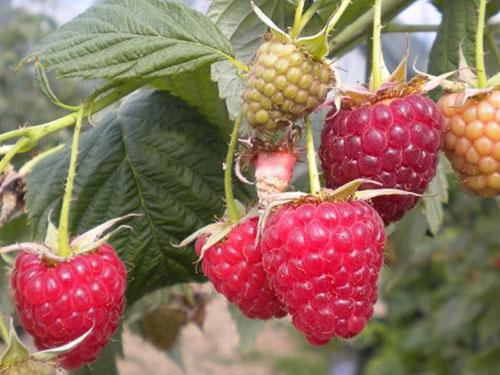

Hercules
"Bryansk Bogatyr" is perfectly adapted to the climatic conditions of the middle zone. This variety is suitable for both domestic and industrial cultivation. The second wave of fruiting occurs closer to autumn, when the pests are no longer so active. Berries of intense ruby color with dense juicy pulp are similar to a truncated cone.
| Appointment | Productivity (kg per bush) | Berry weight (g) | Bush height (m) | Maturation (period) | |
| 2,5-3,5 | 5-7 | 1,5-2 | Mid June. Mid August - early October | ||
Eurasia
A large-fruited variety, belongs to the standard varieties and at the same time is absolutely not picky about the composition of the soil and climate. An upright bush reaches a height of 1.5-1.6 m, so it is very convenient to pick berries from it. They are dark ruby in color, conical in shape, can be stored for quite a long time without loss of marketability.
| Appointment | Productivity (kg per bush) | Berry weight (g) | Bush height (m) | Maturation (period) | |
| 2-3 | 3,5-4,5 | 1,5-1,6 | August - mid September | ||
Golden domes
High-yielding variety of Russian selection. The bush is medium-sized, spreading, consists of 5-6 drooping shoots with small thorns. The berries are rather large, round-conical in shape and bright yellow in color, which later changes to apricot. The pulp is juicy, sweetish dessert, with an almost imperceptible raspberry aroma.
| Appointment | Productivity (kg per bush) | Berry weight (g) | Bush height (m) | Maturation (period) | |
| 2-4 | 5-6 | 1,3-1,5 | End of June - beginning of July. August - mid-October | ||
Polka
This is one of the most popular European varieties, the leader in yield among remontant raspberries. The bushes are practically devoid of thorns, so you can eat fresh raspberries without fear of scratching your hands. By the way, berries are the main advantage of this variety. They are beautiful, large, shaped like a thimble.
| Appointment | Productivity (kg per bush) | Berry weight (g) | Bush height (m) | Maturation (period) | |
| 2-3,5 | 5-6 | 1,5-1,8 | End of July - beginning of October | ||
Ruby necklace
A high-yielding, transportable variety that is also suitable for industrial production. The bush is medium-sized, slightly spreading, with a small number of shoots. The berries are elongated, regular cylindrical, bright ruby color with a delicate sweet and sour pulp. At the end of fruiting, it is best to cut the aboveground part to ground level to avoid freezing of the plant.
| Appointment | Productivity (kg per bush) | Berry weight (g) | Bush height (m) | Maturation (period) | |
| 2-3 | 4-5 | 1,3-1,5 | Mid August - mid October | ||
Yellow-fruited
Yellow raspberries are quite rare in the Moscow region. Many gardeners refuse to grow it due to poor transportability and unsuitability for processing, while forgetting about the advantages of sunny berries. They are excellent for dietary nutrition due to their low acidity and low content of anthocyanins, which often cause allergies..
Table: varieties of yellow raspberries popular in the Moscow region
| Variety name | Ripening period | Berry weight (g) | Berry color | Productivity (kg / ha) | Bush height | Features of the variety |
| Apricot | Remontant | 3,0 | Golden apricot | 117 | Average | Slightly spreading bush, with light brown biennial shoots, prickly at the base. Stems of the first year are green, covered with a waxy coating of medium intensity. Berries are blunt-conical, slightly pubescent. The pulp is tender, sweet and sour, with a mild aroma. It contains 10.4% sugars, 1.3% acids and 36 mg /% vitamin C. Fresh fruit tasting score - 4.5 points. The variety is slightly affected by diseases and pests. |
| Runaway | Early | About 2.5 | Golden apricot | 76,3 | Average | Medium spreading bushes Stems are straight, with a few thorns located at the bottom of the plant. The berries are dull-conical, with a very tender, sweet and sour pulp, containing about 7.1% sugars, 1.6% acids and 19 mg /% vitamin C. The fugitive is resistant to frost, heat and drought. Diseases are damaged no more often than standard varieties. |
| Golden autumn | Remontant | 5 | Golden yellow | 126 | Average | Slightly spreading bush. Annual stems are light brown at the bottom and light green, with a faint waxy bloom at the top. The thorns are soft, greenish, located at the base. The berries are elongated-conical, slightly pubescent. The pulp is tender, sweet and sour, with a slight aroma. Fresh fruit tasting score - 3.9 points. The resistance of the variety to diseases and pests is average. |
| Golden domes | Remontant | 3,8 | Yellow, apricot when overripe | 95 | Average | Bushes are medium spreading. Biennial shoots are light brown, straight, medium spine throughout the length. Annual stems are light green, slightly pubescent. The berries are hemispherical, sweet and sour, with tender pulp. They contain 13.8% dry matter, 6.4% sugars, 1.4% acids and 17.8 mg /% vitamin C. The variety is resistant to pests and diseases. |
| Orange miracle | Remontant | Average 5.5, maximum - 10.2 | Bright orange, with shine | 155 | High | Bushes are powerful, medium spreading. Annual stems are light brown, covered with a slight waxy coating, with slight pubescence. The main part of the greenish thorns is concentrated in the lower part of the stem. Berries are elongated-blunt-conical, with weak pubescence. The pulp is tender, sweet and sour, aromatic. It contains 3.6% sugars, 1.1% acids, 68 mg /% vitamin C.Tasting assessment of fresh berries - 4 points. The variety is moderately resistant to heat, drought, diseases and pests. |
Photo gallery: yellow-fruited raspberry varieties
The fruits of the Apricot variety are suitable for processing. The Beglyanka variety was included in the State Register for the Central District in 2009. The berries of the golden autumn are not only tasty, but also very beautiful. Berries of the Orange Miracle variety tolerate transportation better than other yellow-fruited varieties
Video: autumn fruiting of the Golden Dome variety
Elegant
This exquisite variety is appreciated by all lovers of a stable and abundant harvest. It is recommended for cultivation throughout Russia. A powerful bush is not prone to lodging, it grows no taller than human height. The berries are shiny, in the form of a wide obtuse cone, sometimes weighing up to 8 g. The taste is pleasant, the juicy pulp is sweet and sour. The plant practically does not get sick, the crop retains its presentation for a long time and is suitable for transportation over long distances.
| Appointment | Productivity (kg per bush) | Berry weight (g) | Bush height (m) | Maturation (period) | |
| 2,3-2,7 | 4-6 | 1,6-1,8 | Early August - late September | ||
Repaired raspberry varieties are a real find for summer residents. These plants begin to bear fruit already in the first year, require minimal care, are slightly susceptible to diseases and pests, and at the same time yield up to 2 times a year. Try to plant at least one bush of remontant raspberries and you will not be disappointed.
Tags: raspberry, strip, russia, variety, medium, good
About
«Previous post
Gardeners reviews
Igor Ignatievich, 56 years old: “I have been growing traditional varieties for a long time, just like those of my neighbors. Then someone suggested Apricot Raspberry. I decided to try it, and did not regret it. Delicious and easy to assemble, there are almost no thorns. "
Marina Sergeevna, 24 years old: “We rented a land plot, we immediately decided to start with experiments. We got Tarusa, I liked the yield right away. "
Semyon Petrovich, 67 years old: “We grow both early and late-ripening varieties. We use the early ones for food, we treat our grandchildren, and the late ones are used by the spouse for preparations. "
It is not for nothing that raspberries are called the queen of the garden, they grow on almost every site, without requiring special care. And the variety of varieties adds additional interest to gardeners to the cultivation of this crop.
5 / 5 ( 1 voice)

